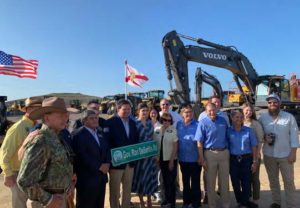New Life in Paradise

Florida Governor Ron DeSantis joins dignitaries for the groundbreaking of the C-43 West Basin Caloosahatchee Reservoir (Photo by SFWMD)
by Eric Eikenberg
Those who cherish America’s Everglades have a lot to be optimistic about these days with forward movement on restoration projects that have been stalled for nearly two decades.
Meanwhile, Florida’s recurring outbreaks of toxic blue-green algae have gotten the attention of policy makers in Washington and Tallahassee who are now moving to reduce algae causing discharges from Lake Okeechobee.
In Tallahassee, Governor Ron DeSantis has urged the legislature to adopt record funding for Everglades restoration. If adopted, DeSantis’ budget request will ensure that Florida’s 50 percent share of restoration costs will be fully funded for the full four years of the Governor’s first term.
It is imperative that the Florida Legislature provide those dollars, especially since Washington has now responded in kind.
After years of half-measures, Congress late last year more than tripled the federal commitment to Everglades restoration, clearing the path for full funding of massive projects like the Everglades Reservoir. The reservoir, once completed, will reduce algae-causing discharges from Lake Okeechobee by more than half.
The agency with primary jurisdiction for completing Everglades restoration, the South Florida Water Management District, has a new Executive Director and Board of Directors who are focused on completing the many projects that, in the past, had been moved to the back burner.

Water begins to flow into the newlycompleted
C-44 St. Lucie Stormwater Treatment Area (Photo by Dr. Stephen Davis, The Everglades Foundation)
Among the new Board’s first accomplishments was renegotiation of leases on state owned land to allow expedited construction of the Everglades Reservoir. The leases had been negotiated in the dead of night by the previous Board, but Governor DeSantis’ new appointees successfully removed what would have been a years long impediment to the project.
The St. Lucie stormwater treatment area has begun operation and ground has been broken on the new Caloosahatchee Reservoir. Once completed, it will improve conditions along the estuary and reduce the recurring outbreaks of toxic blue-green algae that have plagued the Caloosahatchee and the Gulf coast.
Funding has also been secured for completion of a series of modifications to Route 41 — the “Tamiami Trail” that connects Tampa to Miami. When it was built, planners were unconcerned that the new Tamiami Trail created a barrier that restricted the southward flow of fresh water into what is now Everglades National Park.
Modifications already made include construction of several elevated bridges to allow water to flow underneath. Further construction will fully revive a section of the park that, until now, has been on life support.
Eric Eikenberg is CEO of The Everglades Foundation, the leading science-based organization working to restore America’s Everglades



Leave a Reply
Want to join the discussion?Feel free to contribute!